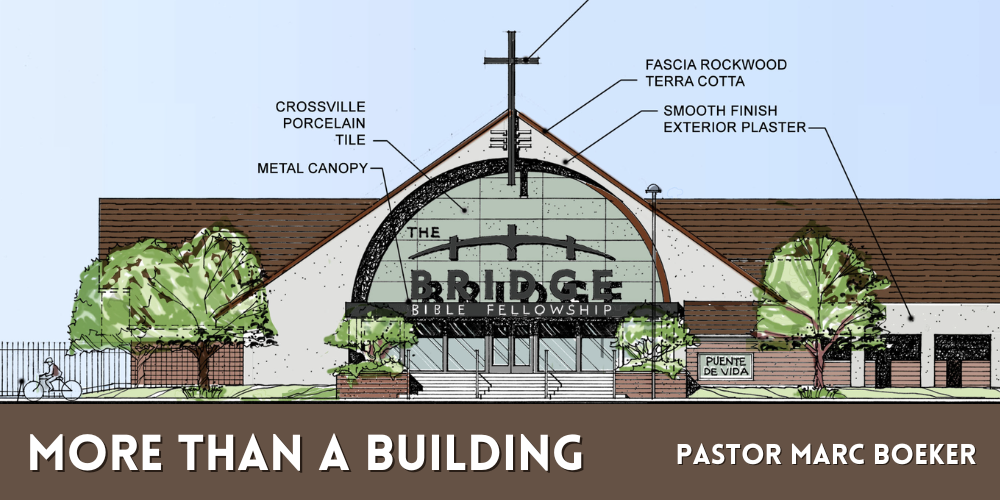Building Update
Construction Timeline
Start Date: Monday, June 23
Project Duration: 2-3 Months
Impact: Use of Worship Center front lobby and Sherman Way entrance will be unavailable.
Next Step: We are actively planning and preparing for what’s ahead!
For years, we have been working to maintain and update the beautiful campus God has graciously provided for the faithful believers of The Bridge Bible Fellowship. Most recently, we have been working on a major renovation of the Sherman Way Facade. This is the largest building project since the E Building (Bridge Kids) was renovated in 2017. As of this week, permits have been approved, and working with a general contractor, we are finalizing a construction timeline. The behind-the-scenes work of many months/years is finally ready to begin on the physical buildings (Fig. 1). If you see construction workers on site, wonder why the lobby of the Worship Center is closed, or find the front steps missing – you can be assured that there is a plan in place for all of this. After a few short months, the face of the church along Sherman Way should be a clear proclamation to the community of an active church.
God has truly blessed us with this property and entrusted us with the great task of stewardship over these material goods. The principle of stewardship is built on two simple premises: God owns it, and we manage it. God gives what is His, and He instructs us to use those things well and use them in a manner that is consistent with His desires and purposes.
How can we grow in our stewardship? What are our priorities in the stewardship of the property God has entrusted to us? How can we better steward this invaluable location: to bring more glory to God, to be a bright light in the neighborhood, to reflect His desires and purposes, to pass on a legacy to the next generations?
More than a Building
In Matthew 16, when Jesus told Peter that He would “build His church,” He was not talking about any kind of structure. He was talking about the founding of a group of people, called for a specific purpose. The simplest understanding of the Greek word ekklesia is an “assembly or congregation.” We often tell each other that the church is not a building but a body: a blood-bought community of the redeemed. We stress this because conflating the church with a building is common and yet destructive to the church’s true identity and mission. Buildings can become distractions from the gospel; they can even become idols.
But just because a good thing is corruptible doesn’t mean it’s not a good thing. In fact, a church is not just a people; it’s a people constituted as a people by gathering in a place. Certainly, it’s true that the Christ’s ekklesia is a people, a family of “living stones” being built into a “spiritual house” (1 Pet. 2:5) rather than, say, a house of brick and mortar. Yet, without some place to gather, like a building, scattered saints cannot become a church.
A building set apart for gospel use is a gracious gift from God, one that’s often been given through the sacrifices of previous generations.
As believers, our physical bodies matter. The Bible affirms that we are incarnate beings (e.g., Rom. 12:1; 1 Cor. 6:19; cf. Pss. 103:14; 139:13–16). Our faith in Christ and obedience to Christ is always embodied. We have never worshiped our Lord in anything but physical bodies and anywhere but in a physical space. Thus, the architecture and aesthetics of our houses of worship—what we see, hear, feel, even smell—invariably shape our communion with Christ and one another week after week. So it’s no surprise that believers through the centuries have created designated spaces for gathered, regular worship. As Christianity expanded, whole houses were set aside as meeting places, and eventually, it was possible to have purpose-built buildings.
Four Benefits of a Building
1. Maximizing Word Ministry
The church grows in size and maturity as the gospel brings faith and conforms us into Christ’s image. This does not require a building, but a building supports the ministry of the Word.
With a dedicated building, the space can be optimized for preaching, teaching, and fellowship. The sound system can be prepared and ready. People know where to gather each week and how to get there. Appropriate classrooms can be prepared for each specific need. Simply put, more people can benefit from the preaching and teaching of the Word when a space is optimized for this purpose.
We should design our spaces to center the congregation’s attention on the living and active Word of God because God has promised it will not return void. This reconfiguration of church buildings and worship halls occurred during the Protestant Reformation. Reformers placed the pulpit in the center, replacing the table for the Lord’s Supper. A building is a strategic part of a church’s trellis that can be intentionally shaped to support vine growth.
2. Stability for the Long-Term
The church is a collection of sojourners, but stability for gospel ministry is a welcome blessing. Some church leaders, especially in missions’ contexts, argue that believers should avoid becoming distracted by buildings because buildings can’t be replicated quickly enough. Such proposals are short-sighted. There is nothing strategic about a congregation being uncertain of where it will meet next month, or if they may be kicked out of their space, or if neighbors may complain if the congregation doubles in size.
Buildings promote stability and give greater freedom to gospel ministry. There are seasons and places where a dedicated church building is simply unavailable. But when such a building is available, a congregation can better sink deep roots into its neighborhood and community.
3. Public Gospel Witness
A church’s public identity in a city is a persistent witness to the gospel. House churches are generally invisible, often intentionally. Again, this can be necessary at times. But the church should aspire to foster a corporate, public testimony to the gospel.
4. Cost Savings
Building projects require significant capital investment. Ongoing maintenance takes up valuable staff time and requires allocations from the annual budget.
But these costs are long-term investments in the ministry of the church. Short-term rental agreements and changing plans cost even more. When churches engage in building projects and upkeep wisely, the congregation can focus its financial resources on gospel work near and far that will have an impact in eternity. It also saves money for future generations of church members who can continue to make good use of the building.
(“Four Benefits” adapted a 9marks article)
Final Thoughts
Give thanks to God for His gracious provision of our campus for more than 80 years. Consider how you can continue to be a part of the stewardship God has given us through the property. How can our current care and provision for the facilities bring greater unity in the body and provide a spiritual home for generations to come? Despite their quirks and faults, our buildings promote health and growth in our gatherings, while the gatherings testify to the communities around us that Christ is our risen Lord.

